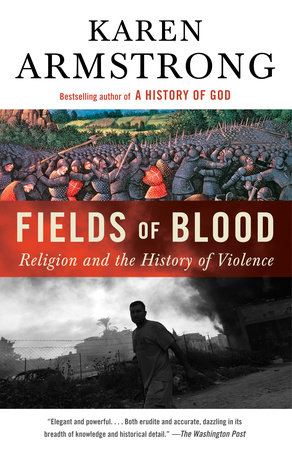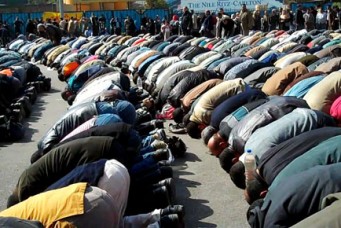Fields of Blood
Does religion cause violence? Or is it just our human nature?
Fields of Blood: Religion and the History of Violence. By Karen Armstrong. Alfred A. Knopf, New York, 2014. 528 pp.
“Whoever took religion seriously?” one exasperated American official remarked of the 1979 Iranian revolution. To him, as to many contemporary observers, the establishment of an Islamic republic in the country seemed atavistic: the modern age is a secular one, so why had mass protests ushered in a theocracy? Karen Armstrong, who cites the U.S. official in Fields of Blood: Religion and the History of Violence, sees no such contradiction. Rising religious fervor is often a reaction to secularization, the two go hand in hand. And, in the secular world, religion has served another purpose: as a scapegoat bearing the blame for conflict and violence. It turns out that no one stopped taking religion seriously.
It is this latter perspective on religion that Armstrong, a former Roman Catholic nun and author of several other books on religious topics including A History of God, The Bible: A Biography, and The Case for God, wants to challenge. “In the West the idea that religion is inherently violent is now taken for granted … a view that, eerily, is expressed in the same way almost every time: ‘Religion has been the cause of all the major wars in history,’” she writes. This may strike some as overblown; I have never heard anyone say this, and certainly don’t recall anyone suggesting that the First World War or Second World War were religiously motivated. Nevertheless, many do accept a diluted version of this argument. Rising sectarian tensions, the Israel-Palestine conflict, and the spread of the Islamic State in Iraq and Syria (ISIS) to other Muslim countries have certainly led many to conclude that in the Middle East religion has bred division and motivated followers to commit great acts of violence.
Armstrong’s exoneration of faith is an impressive work of scholarship, a dense yet sweeping review of almost five thousand years of human history, from the handsome King Gilgamesh, who ruled Uruk in what is now southern Iraq in the third millennium bc, to the U.S.-led “War on Terrorism.” The thrust of her argument depends on three points: firstly, that the modern, Western conception of religion—as a “coherent system of obligatory beliefs, institutions, and rituals, centered on a supernatural God, whose practice is essentially private and hermetically sealed off from all ‘secular’ activities”—is both historically and culturally unique. It does not conform to pre-modern Western understandings of religion as something inseparable from the rest of human existence, or to the Arabic concept of din, which refers to a whole way of life, or the Sanskrit term dharma, which is a total concept, covering laws, justice, morals, and social life.
Second, Armstrong argues that violence is the result of two things, human nature and social organization, both of which are distinct from religion. “War gives us a resolve, a cause. It allows us to be noble,” she writes. A soldier in battle experiences an intensity of emotion that is comparable to a religious encounter. Violence is also an inevitable consequence of human civilization. To support this assertion, Armstrong employs a quasi-Marxist perspective to analyze the way in which the transformation of society from hunter-gatherer to agrarian to industrial has depended on the use of force. The development of agrarian societies rested on the ability of a small elite to coerce the mass population into a life of toil and drudgery. This systemic violence afforded the elite sufficient leisure time to develop the science and arts that would drive human progress. Similarly, the formation of the modern nation-state was wholly dependent on the development of disciplined, well-organized armies.
Third, Armstrong argues that “like the weather, ‘religion does lots of different things.’” Its nature has changed through history. Faith often reflects the underlying structure of society, and although it sometimes justifies systemic violence, it has often checked it, too. The same texts and scriptures have been used to support very different actions, at different times and by different people. For instance, for centuries, the story of Imam Hussein’s death in 680 ad inspired Shiite Muslims to withdraw from political life, while more recently it has inspired political protests against tyranny.
Students of modern politics will be most interested in the final chapters, in which Armstrong applies these three principles to understanding the rise of Islamic extremism in the Middle East. That Islamic fundamentalism has tended to become an agent of violence has less to do with the content of Islamic belief or scriptures, she argues, and much more to do with the way in which secularism was introduced in the region. Unlike in the West, “modernity” arrived in the Middle East as a result of colonial subjugation, which was militarily and systemically violent. Organizations such as the Muslim Brotherhood in Egypt flourished as the country’s economy modernized rapidly and unequally, and were radicalized into violence in response to aggressive secularization. When the ulema or other established authorities are co-opted by government, “self-appointed religious leaders and more simple-minded radicals would step into the breach,” she writes. Men such as Sayyid Qutb, the Brotherhood’s propagandist, were radicalized in Nasser’s jails, just as decades on, the leadership of groups such as Al-Qaeda would develop their views in prisons throughout the Arab World.
Terrorism is almost as hard to define as religion, but one undisputed feature is that it is always about power. “Terrorism is fundamentally and inherently political, even when other motives—religious, economic, or social—are involved,” writes Armstrong. Contrary to popular belief, suicide bombing is not deeply rooted in Islamic tradition—it is a twentieth-century tactic deployed by people of different nationalities and faiths. Armstrong cites interviews with would-be suicide bombers that found most are motivated by the desire to become heroes, or to give their lives meaning through battle and not simply by religious devotion. In fact, she argues that most of those involved in the September 11, 2001 attack on the United States were not religious before joining Al-Qaeda and were under-educated theologically. “The problem was not Islam but ignorance of Islam,” she writes. A similar argument is often made of Western fighters who have joined ISIS: several of those who fled from the United Kingdom, for instance, actually ordered the book Islam for Dummies before their departure.
It is in this final section that Armstrong’s political purpose for writing Fields of Blood becomes clear. The scapegoating of Islam is a convenient way of absolving responsibility for the state-sponsored terror carried out by Western governments: military interventions in Iraq and Afghanistan; drone attacks in Pakistan and Yemen; the continued exploitation of the global poor. It is certainly important that Western governments and their populations acknowledge their role in fueling terrorism, and accept responsibility for the many thousands of civilians who have died in this heavy-handed, vague, but apparently all-encompassing “War on Terrorism.” However, it is perfectly possible to do this while still accepting that religion has played a role.
One problem is that having emphasized how hard it is to define religion, and how it is mistaken to think of it as a discrete practice, Armstrong then shapes her definition to fit her argument. If religion can be all encompassing, why can’t motivations be both political and religious? When she asserts that Al-Qaeda’s actions bear little resemblance to “normative Islam,” does this mean their motivations are not religious? To argue this, she would need to deploy a much narrower definition of religion than the one she advances in the introduction.
Armstrong ascribes one of the most devastating, violent acts of the twentieth century to secular impulses. “Born of modern scientific racism,” she writes, the Holocaust “showed what can happen once the sense of the sacredness of every single human being—a conviction at the heart of traditional religions that quasi-religious systems seem unable or disinclined to recreate—is lost.” While the Holocaust was not religiously motivated, her formulation of this point is problematic. If religion is so hard to define, how do you define “quasi-religious” in this sense? And if, like the weather, religion does lots of things, how can she assert that the sacredness of all individuals is at the heart of traditional faiths? Most religions, after all, distinguish between believers and non-believers, a distinction that has served at times to justify acts of aggression against the latter. As Armstrong correctly points out, the human rights movement and its intellectual roots in Western liberalism has a checkered and at times violent history, but what is it today if not an assertion of the principle of the sacredness of every human life—regardless of nationality, gender, or faith? The problem seems with the implementation, not the idea.
Having said this, Armstrong’s exploration of the role of faith in human civilization makes for a rewarding and thought-provoking read. Her reminder that both sides of the “War on Terrorism” have inflicted suffering on innocent civilians, and that Western governments must acknowledge this, is a timely one. If only commentators spent less time arguing over how “Islamic” ISIS is and more time unpacking the terrible, violent political dynamics that have created it, for instance. The thing is, you can subscribe to a very different history of religion and yet come to the same conclusion.
Sophie McBain is a journalist based in Cairo. She previously served as an assistant editor at the New Statesman. She has written for the New Republic, FT Weekend, Guardian, Monocle, and Spear’s. From 2008 to 2011 she worked as communications assistant for the United Nations Development Programme and a consultant for the African Development Bank based in Tripoli, Libya. On Twitter: @SEMcBain.



